
(Haworth) Haworth, Synopsis Plantarum Succulentarum 191, 1812
Herbarium; Herbarium; Herbarium; Herbarium; Herbarium; Herbarium; Herbarium; Herbarium; Herbarium; Herbarium
O. stricta has similarities with O. dillenii, another beach prickly pear
O. stricta is different from O. anahuacensis, but they are both beach prickly pears.
Original Citation
What is Opuntia stricta?
Opuntia stricta is a coastal prickly pear cactus that occurs on the shores of Florida and other southeastern states. The cactus may also occur naturally in the Caribbean, the Gulf Coast of Mexico, the eastern shores of Mesoamerica, and on the northern shores of South America.
Details
The Flora of North America online reports:
O. stricta is a sprawling or erect shrub up to 2 m across and 1 to 1.5 tall. Cladodes are green, flattened, narrowly elliptic or obovate and 10-25(-40) cm long by 7.5-15(-25) cm wide. The edges are generally not strongly scalloped, but may have shallow scallops. Spines are yellow, sometimes aging to brownish yellow.
Flowers are light yellow and 25 to 30 mm long. Filaments are yellow as are the anthers. The style is yellowish as well. Fruits are purplish inside and out, stipitate, ellipsoid or barrel-shaped, 40-60 by 24-30 mm, juicy, and spineless. Seeds are tan, and 4 by 4.5 mm with a 1 mm girdle.
O. stricta is considered hexaploid, but tetraploid individuals have been reported. Perhaps the differences reflect the existence of two different taxa.
Other Notes
Britton and Rose reported that this Opuntia is found along the Texas coast, and Weniger (1988) reported that the prickly pear may be found in Galveston Bay. The reports of the plants in Texas may have referred to O. anahuacensis because the authors have not observed O. stricta in Texas. It does occur along the coasts of Alabama, Mississippi, and Georgia and is often confused with O. dillenii. However, the two taxa are distinct and different.
Danny Green reports:
The cladodes on the O. stricta are generally oval or spatulate, whereas those of O. dillenii are obovate and/or rhomboid.
The areoles on O. stricta tend to be flush with the surface of the cladode, whereas the areoles on Opuntia dillenii are elevated above the surface of the cladode. For this reason, the margins of the cladodes on Opuntia dillenii may be wavy unlike the smooth or straight margin of O. stricta.
The leaves of O. stricta are shorter, thicker, and pointed upward (more parallel to the surface of the cladode). In contrast, the leaves of the O. dillenii tend to be longer (though not all the time), slimmer, and pointed outwards (more perpendicular to the surface of the cladode).
The spines on O. stricta tend to be straight and perpendicular to the surface of the cladode, and it is common for them to be mottled with brown and yellow. In contrast, the spines on O. dillenii tend to be slightly curved (sometimes very noticeably curved) and usually yellow without mottling.
O. stricta tends to be more shrubby in habit or even prostrate-ascending, usually between 2- to 5-ft tall. Exceptional specimens of O. dillenii may be 10-ft tall and have a very discernible trunk. However, it is more common to see shorter O. dillenii plants that are 3- to 6-ft tall. Irrespective of height, O. dillenii is seldom prostrate-ascending.
Finally, cotyledon morphology separates the two Opuntia species. The cotyledons on O. stricta are heart-shaped, half as long as those of O. dillenii, and pointed outward, whereas the cotyledons of O. dillenii are oval, elongate, and pointed upwards.
Although it is an easy plant to grow where temperatures do not drop below 20F, O. stricta is a sprawling plant and may give a garden an untidy look. It is a cheerful bloomer.

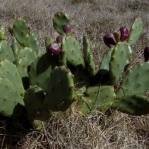
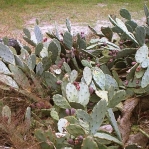
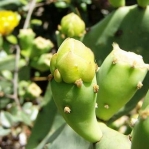
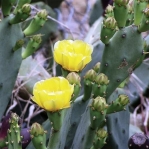
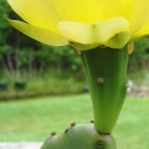
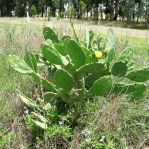
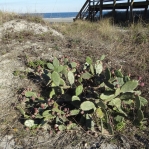
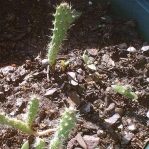
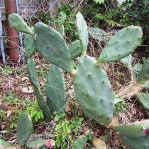
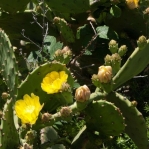
Could you please compare/contrast Opuntia stricta with Opuntia mesacantha? I found this Prickly Pear (https://www.inaturalist.org/observations/155225416) down in Marathon Florida, and to me, it looked like the Opuntia mesacantha I find in the scrub in Central Florida, but iNaturalist suggested Opuntia stricta, and since I was in such a different habitat, I assumed it was right, but am second guessing now. Thanks!
Hi,
O mesacantha is smaller plant, it is not stiff and uprightish. O mesacantha is prostrate. O. mesacantha resembles O. humifusa and O. cespitosa if you have those two
O stricta has stiff stems that rise up from the ground; the stems may run along the ground, but they eventually rise. Eventually O. stricta forms a small bush. Eventually, O. stricta can form a shrub that can be 2-ft-tall (young plants) or over 3-ft-tall (older plants). Push the stem and it will seem woody unlike O. mesacantha.
Joe